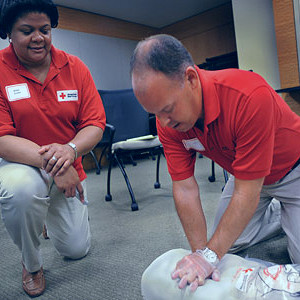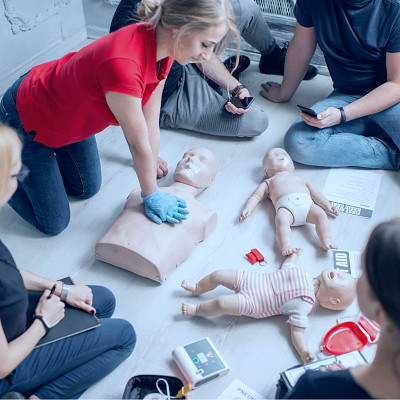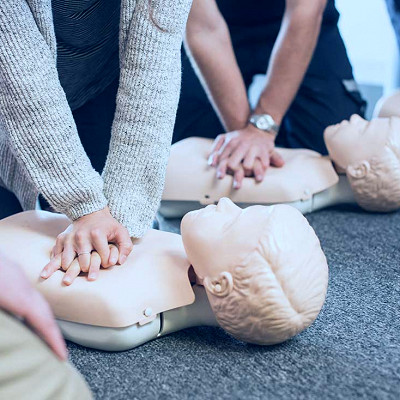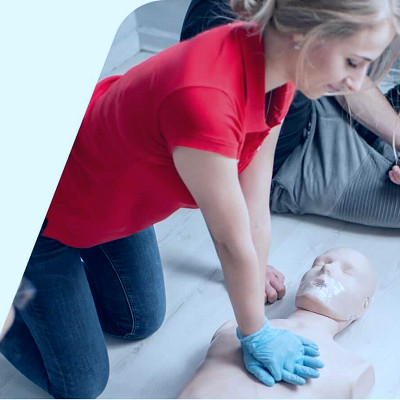 Jarlat Maletych/Shutterstock
Jarlat Maletych/Shutterstock
Features
The Importance of CPR Training
Cardio-Pulmonary Resuscitation (CPR) is a life-saving technique used in emergencies when a person's breathing or heartbeat has stopped. By learning how to perform CPR, you can potentially save a life.
Basics of CPR
CPR involves chest compressions and rescue breaths that help to maintain the flow of oxygen-rich blood to the brain until further medical treatment can restore a normal heart rhythm.
CPR Training Courses
There are many organizations that provide certified CPR training courses. These courses are designed to teach individuals how to perform CPR and use automated external defibrillators (AEDs).
Benefits of CPR Training
By mastering these skills, individuals can act fast during a cardiac emergency, improving the odds of survival and recovery for the victim.
Types of CPR Training
CPR training courses can be categorized into basic life support (BLS) for healthcare providers, advanced cardiac life support (ACLS) for medical professionals, and CPR/AED for the layperson.
Hands-Only CPR
Recently, the American Heart Association has emphasized the importance of hands-only CPR. This method involves performing chest compressions without mouth-to-mouth breaths.
CPR for Infants and Children
CPR techniques for infants and children differ from that for adults. It's important to learn these distinctions in a training course.
Online CPR Training
Online courses are becoming increasingly popular due to their flexibility. They allow individuals to learn CPR skills at their own pace.
Certification in CPR
Upon successful completion of a CPR training course, you can obtain a certification. This is often required for certain jobs, especially in the healthcare field.
The Role of First Aid in CPR Training
A comprehensive CPR course should also teach basic first aid skills. This includes dealing with choking, bleeding, and shock.
AED Training
In addition to CPR, it's crucial to learn how to use an AED. This device can deliver a shock that can potentially restart a person's heart.
Importance of Regular Refreshers
CPR guidelines and techniques can change over time. Regular refresher courses ensure you are up-to-date with the latest best practices.
Bystander Effect
CPR training also teaches how to overcome the bystander effect, the phenomenon where people are less likely to offer help to a victim when other people are present.
Psychological Aspects of CPR
Performing CPR on someone can be a stressful experience. A good training course will also cover how to manage this stress.
Legal Aspects of CPR
It’s important to understand the Good Samaritan laws that protect individuals who provide aid during emergencies.
CPR in the COVID-19 Era
During the pandemic, there have been updates to CPR guidelines to reduce the risk of virus transmission.
CPR for Drowning Victims
Specific techniques are needed when performing CPR on drowning victims. These are covered in specialized CPR courses.
Importance of Fast Action
The sooner CPR is started, the better the victim's chances of survival. Every minute counts.
Community Impact of CPR Training
Widespread CPR training within a community can significantly increase survival rates for out-of-hospital cardiac arrests.
Commitment to Learning CPR
Taking the responsibility to learn CPR is a commitment to the health and wellbeing of one's family, friends, and wider community. Your knowledge and skills could make all the difference in a life-threatening situation.
Interesting notes and facts
1. The Lifesaving Power of CPR: CPR or Cardiopulmonary resuscitation is a critical emergency procedure that can dramatically improve the survival chances of a person who has experienced a cardiac arrest. The American Heart Association reports that CPR, when administered immediately, can double or even triple a cardiac arrest victim's chances of survival.2. Importance of CPR Training: Despite the effectiveness of CPR, a study shows that less than half the people who experience an out-of-hospital cardiac arrest receive the help needed before professional help arrives. This highlights the importance of CPR training for everyone, not just healthcare professionals.
3. Accessibility of CPR Courses: With the rise of technology, many organizations offer CPR training online, making it accessible for everyone. These courses are designed to be flexible and comprehensive, catering to different learning styles and schedules.
4. Components of a CPR Course: A typical CPR course includes learning chest compressions and rescue breaths for adults, children, and infants, along with how to use an automated external defibrillator (AED). It also covers the signs and symptoms of a cardiac arrest, ensuring that individuals can recognize when CPR is needed.
5. Hands-on Training: Although online courses provide the theoretical knowledge, hands-on training is vital for mastering CPR. Many organizations offer blended learning courses that combine online instruction with in-person skills sessions.
6. Certification and Recertification: After completing a CPR course, you can obtain a certification that is usually valid for two years. However, due to the importance of maintaining these life-saving skills, regular recertification is recommended.
7. CPR for Special Groups: Some CPR courses are tailored for specific groups like healthcare professionals, teachers, lifeguards, or childcare providers, focusing on situations they're most likely to encounter.
8. Community Impact: Communities with higher rates of CPR training have shown to have higher survival rates from cardiac arrests. Therefore, taking a CPR course not only benefits you as an individual but also has a broader impact on society.
9. The Role of AED in CPR: AEDs are devices used during a cardiac arrest to help restore a normal heartbeat. Most CPR courses include AED training due to its crucial role in increasing survival rates, especially in situations where professional medical help may not immediately be available.
10. Empowering Individuals: Ultimately, undertaking a CPR course empowers individuals with the confidence and skills to act in a life-threatening situation. It's a small investment of time and effort that could make a world of difference.
Vocabulary
- CPR Training Courses – Classes that teach individuals how to perform cardiopulmonary resuscitation (CPR), a life-saving technique used during medical emergencies.
- Holistic Medicine – A form of healing that considers the whole person -- body, mind, spirit, and emotions in the quest for optimal health and wellness.
- Aromatherapy – The use of aromatic plant extracts and essential oils for healing and cosmetic purposes.
- Organic Food – Food that is grown without the use of pesticides, synthetic fertilizers, genetically modified organisms, or ionizing radiation.
- Yoga – A physical, mental, and spiritual practice that originated in ancient India, which involves a series of postures and breathing exercises.
- Pilates – A system of exercises using special apparatus, designed to improve physical strength, flexibility, and posture, and enhance mental awareness.
- Veganism – The practice of abstaining from the use of animal products, particularly in diet, and an associated philosophy that rejects the commodity status of animals.
- Ayurveda – An ancient Indian system of medicine that uses a wide range of treatments and techniques.
- Naturopathy – A system of alternative medicine based on the theory that diseases can be successfully treated or prevented without the use of drugs, by controlling diet, exercise, and massage.
- Probiotics – Live bacteria and yeasts that are good for your health, especially your digestive system.
- Antioxidants – Substances that may protect your cells against the effects of free radicals.
- Omega-3 fatty acids – Essential fatty acids that have heart-healthy benefits.
- Gluten-Free Diet – A diet that excludes the protein gluten, which is found in grains such as wheat, barley, and rye.
- Meditation – A practice where an individual uses a technique – such as mindfulness, or focusing their mind on a particular object, thought or activity – to train attention and awareness, and achieve a mentally clear and emotionally calm and stable state.
- Detox – A process or period of time in which one abstains from or rids the body of toxic or unhealthy substances.
- Chiropractic – A system of complementary medicine based on the diagnosis and manipulative treatment of misalignments of the joints.
- Homeopathy – A system of natural health care that has been in worldwide use for over 200 years.
- Acupuncture – A form of alternative medicine and a key component of traditional Chinese medicine in which thin needles are inserted into the body.
- Herbal Medicine – The study of the use of medicinal plants.
- Hydrotherapy – The use of water in the treatment of different conditions, including arthritis and related rheumatic complaints.
- Osteopathy – A way of detecting, treating and preventing health problems by moving, stretching and massaging a person's muscles and joints.
- Vegan Diet – A diet excluding all animal products including meat, dairy, and eggs.
- Ketogenic Diet – A low carb, high fat diet that offers many health benefits.
- Plant-Based Diet – A diet consisting mostly or entirely of foods derived from plants.
- Cardiovascular Exercise – Any type of exercise that increases heart rate and improves the condition of the heart.
- Strength Training – A type of physical exercise specializing in the use of resistance to induce muscular contraction.
- Flexibility Training – Any exercise that improves the ability of a joint to move through its full range of motion.
- HIIT (High-Intensity Interval Training) – A cardiovascular exercise strategy alternating short periods of intense anaerobic exercise with less intense recovery periods.
- Superfoods – Nutrient-rich food considered to be especially beneficial for health and well-being.
- Organic Farming – A method of crop and livestock production that involves much more than choosing not to use pesticides, fertilizers, genetically modified organisms, antibiotics and growth hormones.
- Mindfulness – A mental state achieved by focusing one's awareness on the present moment, while calmly acknowledging and accepting one's feelings, thoughts, and bodily sensations.
- Reiki – A therapy often described as palm healing or hands-on-body healing in which a practitioner places hands lightly on or over a patient's body to facilitate the patient's process of healing.
- Reflexology – A system of massage used to relieve tension and treat illness, based on the theory that there are reflex points on the feet, hands, and head linked to every part of the body.
- Tai Chi – An ancient Chinese tradition that, today, is practiced as a graceful form of exercise.
- Qigong – A centuries-old system of coordinated body-posture and movement, breathing, and meditation used for the purposes of health, spirituality, and martial-arts training.
- Biofeedback – A technique you can use to learn to control your body's functions, such as your heart rate.
- Hypnotherapy – A type of complementary therapy



